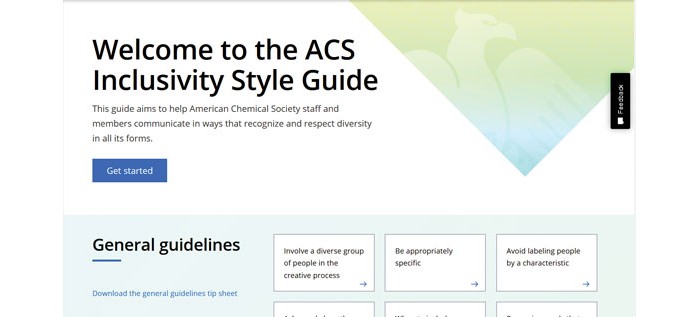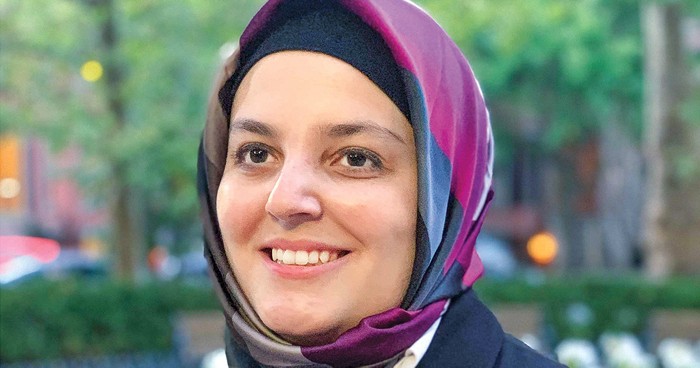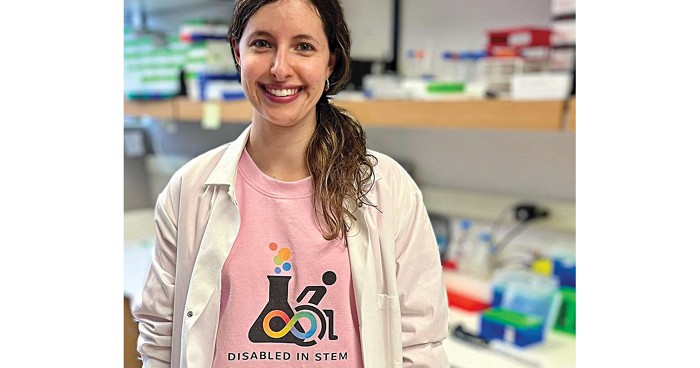Advertisement
Grab your lab coat. Let's get started
Welcome!
Welcome!
Create an account below to get 6 C&EN articles per month, receive newsletters and more - all free.
It seems this is your first time logging in online. Please enter the following information to continue.
As an ACS member you automatically get access to this site. All we need is few more details to create your reading experience.
Not you? Sign in with a different account.
Not you? Sign in with a different account.
ERROR 1
ERROR 1
ERROR 2
ERROR 2
ERROR 2
ERROR 2
ERROR 2
Password and Confirm password must match.
If you have an ACS member number, please enter it here so we can link this account to your membership. (optional)
ERROR 2
ACS values your privacy. By submitting your information, you are gaining access to C&EN and subscribing to our weekly newsletter. We use the information you provide to make your reading experience better, and we will never sell your data to third party members.
Diversity
5 lessons from a year of implementing the ACS Inclusivity Style Guide
Inclusive language and images make C&EN more accurate and respectful
by Sabrina J. Ashwell , Manny I. Fox Morone
March 7, 2023

In December 2021, the American Chemical Society released the ACS Inclusivity Style Guide, a guide on inclusive language and images. The aim was to help ACS staff and members communicate in ways that recognize and respect diversity in all its forms. The guide grew out of resources that Chemical & Engineering News created to help newsroom staff create bias-free content. So while inclusive language was not new to C&EN—indeed, we have long valued diversity, equity, and inclusion, and respect and aimed to show those values in our coverage—the ACS Inclusivity Style Guide expanded the topics and raised the visibility of inclusive communication principles. (C&EN is published by ACS but remains editorially independent.)
We reflect on five lessons learned after a year of implementing the ACS Inclusivity Style Guide at C&EN and how we can continue to foster inclusion.
1. Be specific. Several ACS Inclusivity Style Guide guidelines, including “Be appropriately specific,” “Recognize words that assume a cultural norm,” “People of color,” and “LGBTQ+,” helped C&EN recognize when generic terms blur the truth. A phrase like “underrepresented groups” requires context—underrepresented relative to what? And what kinds of groups—racial and ethnic, gender, socioeconomic status, education level, nationality, or something else?
The ACS Inclusivity Style Guide emphasizes that naming specific identities can be both more accurate and empowering for marginalized people. For example, a C&EN article defines “underrepresented” in terms of racial and ethnic groups in science: “people from racial and ethnic groups that are underrepresented in science—such as Black, Latino, and Native American people.” Another article notes the US National Science Foundation’s definition of underrepresentation while pointing out how that definition may exclude subpopulations: “The National Science Foundation defines [races and ethnicities that are underrepresented in US academic institutions] as Black, Hispanic, Latino, and Indigenous peoples, and there are valid arguments to also include Southeast Asian people as underrepresented.” These examples show that making language inclusive is not a replace-all task; each change should be made thoughtfully.
2. When in doubt, ask. Another key lesson from the ACS Inclusivity Style Guide is recognizing that each person is unique and that it’s important to ask people how they want to be described. The guide’s recommendations should not supersede someone’s lived experience or expressed identity, and ultimately, asking a person how they identify can be the only way of knowing how to refer to them. For example, people of an older generation may not identify as “queer” because of the historical use of the term as a slur, while many people self-identify that way. Similarly, because a person’s gender and pronouns can’t be assumed (and can change over time), asking the person is the only way to ensure that your information is correct and current. When interviewing sources for news coverage or registering participants for an event, work questions about pronouns into your reporting and intake processes if that information is relevant to what you’re doing. For the 2022 edition of Trailblazers, editors sent a form to the LGBTQ+ chemists being celebrated so they could describe their identity in their own words.
3. Be creative. Several guidelines in the ACS Inclusivity Style Guide, such as “Avoid using disability-related terms to describe something negative” and “Cultural appropriation and misinterpretation in language,” encourage people to avoid defaulting to clichés that can show bias or perpetuate stereotypes. These guidelines have pushed C&EN staff to be creative—to describe things in new ways, work around quotations with harmful language, use direct wording instead of problematic metaphors, and create new illustrations instead of relying on stock images that contain stereotypes. For example, an article on artificial intelligence for drug discovery uses “toxic potential” instead of “dark side” to describe concerns about AI’s use. This wording is both immediately clear to readers and avoids equating darkness with something negative. Similarly, a 10 Start-Ups to Watch profile describes the company’s “first focus” instead of “first frontier” to avoid using a word closely tied to a history of violence against Indigenous people. And a profile of a green chemistry professional uses “expert” instead of “guru” to avoid casually using a term for a revered figure in Hinduism.
4. Think beyond the words. Another key lesson learned was the need to take a holistic view of inclusive communication. C&EN staff use the ACS Inclusivity Style Guide in conjunction with checklists created by the newsroom’s Diversity, Equity, Inclusion, and Respect Committee to ask several questions to ensure content is inclusive and reflects the diversity of the chemical sciences:
Whose stories should we tell?
Who should tell those stories?
How should those stories be framed—in story structure, sentence structure, and images?
Who should be included in the article, whether through quotations, data points, or images?
Whose perspective is missing, and who benefits from that omission?
For example, a story about racial bias in US National Science Foundation funding uses active voice to explicitly name the source of the bias: “The US National Science Foundation (NSF) has consistently funded White researchers at higher rates than researchers from other racial and ethnic groups.” In contrast, using the passive voice, such as “White researchers have been consistently funded at higher rates by the US National Science Foundation,” would subtly imply that White researchers are solely responsible for their higher funding rates.
And in a story on ACS’s 2022 salary survey, graphs show all surveyed demographic groups, along with the sample sizes, to help make those groups visible. A note informs readers that ACS considers data with fewer responses unreliable.
5. Create a culture that encourages feedback. Even before we started drafting the Inclusivity Style Guide, we knew that rules alone would not make our communication inclusive; we also needed a culture that encouraged people to seek and provide feedback. A year of implementing the guide has solidified the importance of pairing the guidelines with processes for discussing the inclusivity of content. C&EN staff members use Slack, a workplace messaging app, to communicate with one another. A dedicated channel in Slack allows staff to ask questions about the language and images in their stories and weigh in on other people’s questions.
The guideline to involve a diverse group of people in the creative process has also encouraged staff to consider hiring external reviewers known as sensitivity or authenticity reviewers. These are editors who use their lived experience to help ensure a story authentically and respectfully discusses people with a shared identity such as a certain race, disability, or gender. Importantly, C&EN recognizes the importance of these reviewers’ feedback by paying them fairly. These reviewers have helped C&EN create accurate and inclusive content. For example, a sensitivity editor ensured a GIF of a sign was accurate in an article on American Sign Language in chemistry, and an editor recommended ways to acknowledge gender diversity in an article on sperm-targeting birth control.
Looking ahead
The ACS Inclusivity Style Guide has been an important tool in helping staff uphold C&EN’s values of making journalism that matters, putting our audience first, and doing the right thing. Implementing the guide in our newsroom has taught us the importance of flexibility and humility—of approaching inclusive communication from a place of learning rather than shame and blame. Language is constantly changing, and we will need to change with it to remain respectful and inclusive of the diverse audience we hope to reach.
We also know that inclusive communication, including words, images, and accessibility, is just one way to promote inclusion. To create a more inclusive newsroom, C&EN will need to diversify its staff, share stories that celebrate the diversity of chemical scientists, and continue to foster a culture that encourages continuous learning and feedback. We invite you to tell us how we’re doing: you can send general feedback to cenfeedback@acs.org or submit a letter to the editor at edit.cen@acs.org. You can also provide comments or ask questions about the ACS Inclusivity Style Guide by emailing ISG@acs.org. The guide team reviews the guide for updates three times a year and makes changes at other times as necessary.




Join the conversation
Contact the reporter
Submit a Letter to the Editor for publication
Engage with us on Twitter